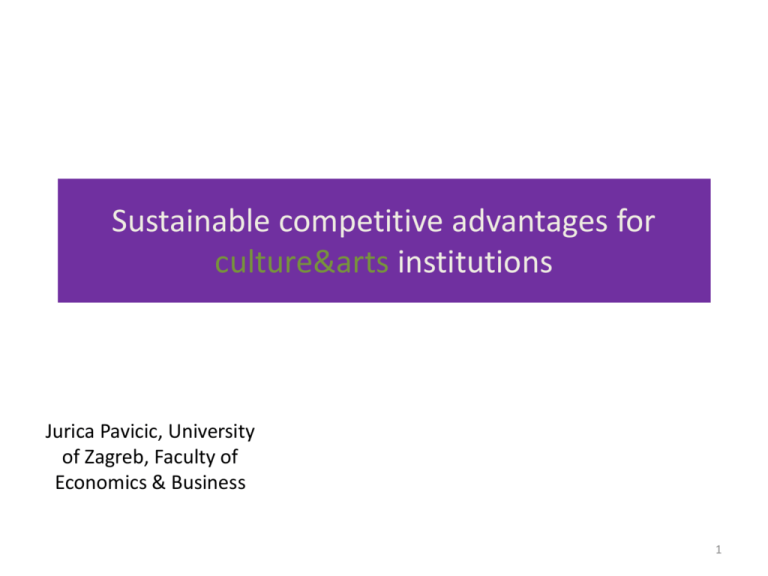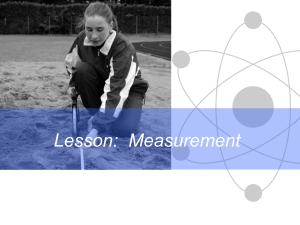Genericke strategije
advertisement

Sustainable competitive advantages for culture&arts institutions Jurica Pavicic, University of Zagreb, Faculty of Economics & Business 1 Generic Strategies: Mini-lecture 2 Generic strategies 1. Cost leadership (advantages) 2. Differentiation 3. Focusing • Used for achieving sustainable competitive advantage! 3 “Competitive advantage cannot be understood by looking at a firm as a whole. Advantage stems from the many discrete activities an organization performs – designing, producing, marketing, delivering, and supporting products/services. Each of these activities can contribute to a firm’s relative cost position and create a basis for differentiation.” Michael E. Porter 1 PUBLIC LIBRARIES??? 4 “Competitive strategy is about being different. It means deliberately choosing to perform activities differently or to perform different activities than rivals to deliver a unique mix of value.” Michael E. Porter 2 PUBLIC PERFORMERS??? 5 Generic strategies Strategic advantage Mass Narrow Specific elements perceived by consumers/clients Low cost position Differentiation Cost leadership Focus NATIONAL HERITAGE??? 6 Generic strategies Competitive advantage Total market Differentiation Cost leadership Differentiation Market niche Competitive arena Low(er) costs Focusing on lower costs Focusing on differentiation 7 Generic strategies CONCERT HALLS??? Forces influencing industry Cost leadership Differentiation Focus Entrance barriers Price cutting Loyalty Being difficult to immitate Power of consumers Lower prices for key consumers (Big) consumers are not so strong Consumers have less power Power of suppliers Better isolation/safety triggers against strong suppliers Better position in case of higher prices Supplier’s price could be consideres as irrelevant Threats from substitutes Lower prices - in order to survive Consumers are loyal Specific characteristics/skills Competitors Better (price) competitiveness Brand loyalty Competitors could not differentiate 8 1. COST LEADERSHIP 9 1. COST LEADERSHIP STRATEGY Sources of cost cutting….. MUSEUMS??? Economies of scale Experience curve Stock/reserve control Avoiding of marginal consumers/customers Cost minimisation 10 COST LEADERSHIP STRATEGY (AGAIN ) Can lower costs lead to sustainable competitive advantage? YES! How? Suppliers’ power reduced! Consumers’ power – reduced! Substitues – less attractive! Rivalry – reduced! 11 COST LEADERSHIP STRATEGY - What lessons could be learned for the benefit of destinations (and their culture & arts institutions) – if we use belowmentioned examples? 12 COST LEADERSHIP STRATEGY (destinations again)! Potential risks 1 • New competitors 2 • Flexibility issues and unpredictable costs 3 • Technology issues 4 • Market issues 5 • Costs inflation 13 COST LEADERSHIP STRATEGY….. ! Lower costs – lower prices! Lower costs – previous prices! • Profits could be skyrocketed! • Less profit per unit • Large total profit (quantities & market share) • Being a leader 14 2. DIFFERENTIATION STRATEGY 15 DIFFERENTIATION STRATEGY “Be Distinct or Be Extinct” Tom Peters 16 DIFFERENTIATION STRATEGY Key sources of differentiation (MUSICIANS???) Differences in „inputs” Differences in technology („Grdovic syndrome”) Differences in activities Differences in distribution (channels) 17 DIFFERENTIATION STRATEGY Additional sources of differentiation Differences in scope Advantage in „product lines” Flexibility in terms of environment(s) Easy to use (for consumers) 18 DIFFERENTIATION STRATEGY Differentiation leads to something better compared with competitors (higher prices, higher profits…..) Consumers are provided with added value and their needs are satisfied in a better way 19 DIFFERENTIATION STRATEGY ZADAR SUMMER SCHOOL(S) Successful strategy is based upon few basic pillars….. 1. It should generate value for users/consumers 2. It should provide adequate value perception 3. It should be difficult to imitate (sustainable as long as possible) 4. It should be „implementable” 20 DIFFERENTIATION STRATEGY Risks 1 2 3 • Loyalty could be expensive • Market for differentiated market offers is shrinking (in certain contexts) • Competitors are coming to join the market! 21 DIFFERENTIATION STRATEGY • Symbols, media, atmosphere, events….. • performance, style, characteristics …… Image differentiation Product differentiation Staff differentiation Services differentiation • Delivery, education for consumers, advices….. 22 POSSIBLE LESSONS LEARNED FOR SMITHSONIAN INSTITUTION – SEE AND USE BELOWMENTIONED EXAMPLES?! 23 3. FOCUSING STRATEGY 24 FOCUSING STRATEGY • Previous two strategies combined, or? • The difference is in the SIZE of the targeted market 25 FOCUSING STRATEGY GALLERIES??? Characteristics Low market share Differentiation according to market segment Low prices for certain segments Overlapping of segmentation and differentiation 26 FOCUSING STRATEGY MOVIES FOR KIDS??? FOCUS ON COSTS • Goal: cost leadership in certain market segment FOCUS ON DIFFERENTIATION • Goal: „product” differentiation within the targeted segment 27 FOCUSING STRATEGY POETRY BOOKS??? Risks: 1 2 • Attractive for new competitors • Dependence on certain (specific) segment 28 IMPLEMENTATION PROBLEMS! 1. Using more than one strategy 2. Using one strategy 3. Co-ordination 4. Sustainability 29 What if none of Porter’s generic strategies is chosen? 30 ….They are „stuck in the middle”! Competitive advantage Total market Narrow market segment Competitive arena Lower costs Differentiation Cost leadership Differentiation Stuck in the middle Focusing on lower costs Focusing on differentiation 31 „Stuck in the middle” situation….. • Characteristics: • They do not have any particular competitive advantage • Their profitability is low • They are losing their consumers/customers 32 “Finally, strategy must have continuity. It can’t be constantly reinvented.” Michael E. Porter 33






